Owners of country houses are actively using various powerful household appliances. Oven, washing machine, coffee machine, bread maker - all these devices put a heavy load on the network. In suburban conditions, the power grid can be unstable, which leads to breakdown of household appliances. Therefore, the owners install voltage stabilizers on devices in the country or in an apartment.
Description and types
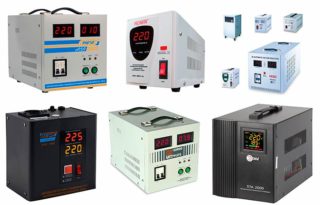
A stabilizer is a device that converts input energy and maintains the supplied voltage within a certain range. It performs a protective function, since only after passing the stabilizing device, household appliances receive electricity for operation.
The best stabilizer option is an automatic device. It does not require human intervention and reliably protects electrical appliances.
For home use at 220 V, there are:
- Network stabilizers. They are connected to a regular outlet for certain devices.
- Trunk. Installed on all appliances in the house and connected to the mains. The total load exceeds 4000 W.
The main tasks of the stabilizer are:
- Bringing the incoming voltage to a normal level.
- Switching off devices with strong surges in the network.
The stabilizer is installed next to the switchboard. Cannot be mounted in basement or attic.
There are different types of devices that you should be familiar with before purchasing. They differ in their principle of operation and application conditions.
Electromechanical
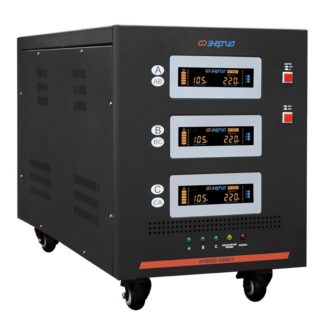
The device is based on an autotransformer controlled by an electronic circuit. The adjustment is carried out by a rotary graphite contact, equipped with a servo drive. They can be used as network or trunk devices, depending on their rated power.
Advantages:
- Operating voltage range - from 130 to 260 V.
- No interference.
- The output voltage waveform is not distorted.
- Overload resistance.
The disadvantages include the inability to work in low temperature conditions and a low stabilization rate. Also, during operation, users may hear noise. It is better to use such stabilizers with infrequent surges in the power grid.
Relay and hybrid
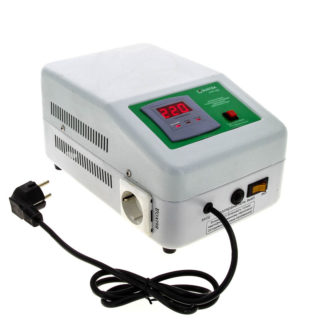
The basis of such devices is also an autotransformer. The difference lies in the way the voltage changes - in relay and hybrid devices, it occurs due to the switching of the winding sections.
Relay stabilizers can cause the lamps to flash. Also, clicks can be heard during operation, so it is better to install such a device in a place far from the recreation area.
Benefits:
- High-speed performance.
- The response zone is increased to 105 V.
- No maintenance required.
- The service life is 10 years.
- They work at temperatures up to -30 degrees.
- They can work outside.
- Withstands a load of 110% of the nominal value.
Relay devices are more expensive than electromechanical ones.
To remove the disadvantages of relay and electromechanical stabilizers turned out to be in a hybrid device. It operates in a wide range from 105 V to 280 V. The voltage regulation is smooth. If the voltage drops below 140 V, the relay part starts to work, providing 220 V.Disadvantages - installed on the floor and cannot function at temperatures below 0 degrees.
Electronic
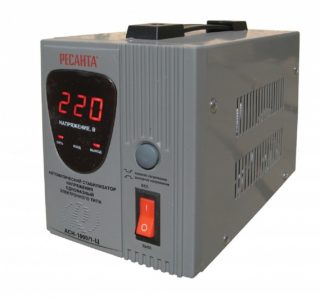
Works on the basis of thyristors and triacs instead of relays. This leads to the fact that the output maintains a normal voltage when the input drops to 60 V. The operation is silent, since there are no moving parts. The service life is high, they have an extended warranty of up to three years. Electronic stabilizers are small in size and can be conveniently mounted on the wall. They are even used in apartment buildings. They have a small regulation step. The disadvantages include the high cost of stabilizers.
Other types
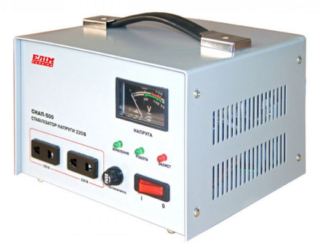
The listed types of stabilizers are the main ones and are most often used in private houses. But there are other devices with a different principle of operation. These devices include ferroresonant stabilizers. They are suitable for small houses. They consist of a core, between the windings of which ferroresonance occurs, and capacitors. The advantages include high performance and reliability. Minus - low efficiency, noise, dimensions, cost.
A separate group includes electronic stabilizers with double inverter conversion. These are expensive instruments and are best stacked on the single most valuable instrument. They can compensate for any drops in the network.
Criterias of choice
Before choosing a voltage stabilizer, you need to find out which network it will connect to. A single-phase device is suitable for 220 V. 380V requires three-phase or 3 single-phase devices. The choice depends on the following conditions:
- If the house has equipment designed for 380 V, one three-phase stabilizer is installed.
- If there is no such electrical engineering, it is more profitable to mount three single-phase devices.
The main criteria by which a stabilizer is selected are voltage, adjustment limits, accuracy and the presence of additional functionality.
Power
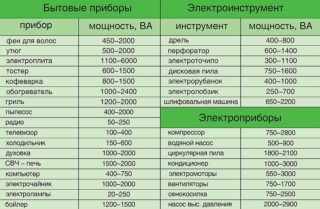
To select a power stabilizer, you can use two methods. The first is to calculate the total load of all connected electrical appliances. The second recommended technique is to look at the cutoff current of the machine at the input. It is already selected taking into account the maximum load and with a power reserve. Then, with a 50 A circuit breaker installed, the power of the stabilizer should be 220 * 50 = 11 kW. This value selects the closest stabilizer in terms of load (in this case, 10 and 15 kW). At full load, a higher value is taken, with an incomplete load, a lower value must be selected.
If a three-phase stabilizer is installed, the power is multiplied by 3. For a 16 A machine, the power is 16 * 220 * 3 = 10.56 kW.
Regulation limits
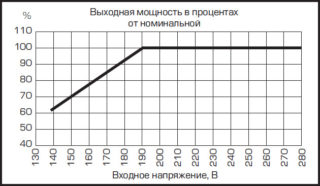
The input voltage ranges indicated in the documentation are the values within which the stabilizer will equalize the current. If the parameters differ, the device turns off.
Before choosing a device for this parameter, you should measure the voltage in the house and write down the maximum and minimum values. It should also be borne in mind that when working near the border of the range, the accuracy of the supported parameters drops to 18%. The device, which is operated for a long time under such conditions, overheats and may break.
Output voltage support accuracy
It is selected according to the values specified in the passport for household appliances. Most electrical appliances operate at 5-7% accuracy. The intensity of the lamps changes noticeably already at 3% voltage deviation. When buying, you need to select a smaller limit.
Additional options
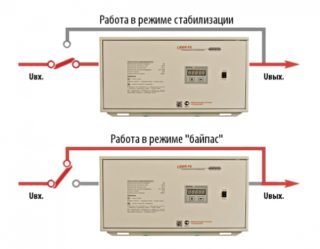
Many stabilizers are equipped with a function of protection against high currents and voltages. If a model is purchased without this function, an additional protective relay must be installed.
There is such a device as a bypass. This is a switch that you can use to directly connect the input and output. It is used when the stabilizer breaks down for a while, until the repair or replacement of the failed device is made.
Stabilizers come with multiple displays. They indicate the current load, input and output values, operating mode.
Any devices plugged into the mains heat up. Temperature can lead to distortion and breakdown, therefore it is recommended to buy models with cooling.
Popular brands
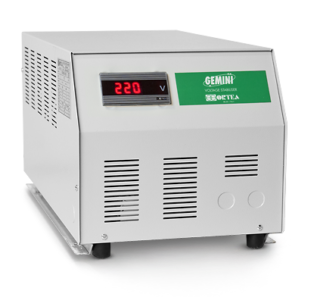
The Italian company ORTEA occupies a leading position in the sales of stabilizers. They have offices in all major world countries. They offer devices of the Gemini line for 20 kVA, Orion up to 250 kVA, Sirius new up to 6000 kVA and others. Work at low temperatures
The Russian firm "Bastion" also manufactures protective equipment for electrical engineering. The company has its own design office, so they are fully involved in the entire production process and equipment verification.
Rekanta manufactures its equipment in China. This company is the leader in sales of welding and protective equipment. Service centers are represented in any country in the world. The popular relay stabilizer ASN - 2000 N / 1-Ts operates at input voltages from 140 to 260 V. Power is 1 kVA. Weighs 4 kg. The cost is approximately 3500 rubles.
Shtil also plays a leading role in the production of voltage stabilizers. There are presented 2 series of protective devices - "Matrix" with a power of 0.5 kVA - 2 kVA and home inverter "InStab" with a power of 0.5 kVA and an accuracy of at least 2%. The advantages include seamless switching and an input noise filter.








